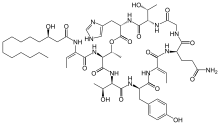Jagaricin
Jagaricin is a lipopeptide with antifungal properties that is involved in the wet rot infection process. It is produced by the wet rot bacterium Janthinobacterium agaricidamnosum . Pure jagaricin causes wet rot in fungi, while bacteria that lack the jag genes to produce the peptide cannot cause rot.
The peptide could be used as a new active ingredient in fungal infections ; In initial tests as an antimycotic agent, jagaricin showed very good effectiveness against pathogenic fungi and low cell toxicity .
literature
- Graupner K, Scherlach K, Bretschneider T, Lackner G, Roth M, Gross H, Hertweck C .: Imaging Mass Spectrometry and Genome Mining Reveal Highly Antifungal Virulence Factor of Mushroom Soft Rot Pathogen . In: Angew. Chem. Int. Ed. Engl. 2012, doi : 10.1002 / anie.201206658 .
Web links
- A schematic showing the procedure for identifying jagaricin using imaging mass spectrometry in Nature Chemistry , 5, 155–157 (2013), doi : 10.1038 / nchem.1583
Individual evidence
- ↑ Jagaricin as the lead substance in antifungal development. From putrid fungus to therapeutic agent? Organic Chemistry Portal, January 13, 2013.
- ↑ Matthias Brock: Microorganism in the headlines: Bacteria teach fungi to go moldy. (PDF) BIOspektrum 02.13, p. 170.
